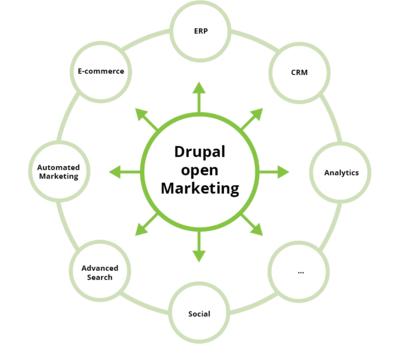
Joris De Groot
Anyone who uses a Drupal website today as a marketing tool cannot ignore the fact: optimizing conversion is no longer just about the form of the content, but about relevant context. The more relevant the message to your visitor, the more effective it will be and the greater the chance that your visitor will convert. Simple, right? Also with Drupal there are many possibilities to offer personalized content to your visitor. In this article we outline today's situation and look at tomorrow's possibilities.
Research has shown that 48% of visitors stay longer with personalization. 74% of visitors even become frustrated when they see content that is not relevant to them. (source: smart insights). By the way, 87% of visitors indicate that they find it perfectly acceptable to be offered personalized content, as long as it remains relevant or the offer comes from a company with which they already came into contact. (source: experian marketing services) According to Hubspot, contextually relevant call to actions are 178% more efficient. Clearly, presenting relevant content has a major impact on the customer experience and therefore: online conversion.

And yet content personalization is often underestimated and misunderstood. After all, its implementation has some requirements and also has an impact on the marketing team.
There is no one size fits all solution, because every company has a different situation: logged-in users US anonymous visitors, presence of CRM, ownership of offline and online data... All these things have an impact on the personalization strategy.
Depending on the chosen strategy (see below), the personalization scenarios will be based on the following basic principles:
Often these parameters are combined to create a specific context, for example:
The possibilities are endless, and that is also one of the pitfalls of personalization. So start simple and build up gradually, based on insights into visitor numbers.
As with other adjustments with an impact on the website, we start with a strategy: the personalisation strategy. This includes some crucial aspects.
Just like with a general digital strategy, we start with the review of the KPIs. What do you want to achieve? More sales or a better experience? Do you want more leads, or less contact with the helpdesk? Every company has different needs: our strategists make your specific KPI's concrete by means of workshops. Next, we ask a few simple questions:
What am I going to personalize? Which content on the website is best suited to personalize? How can the marketing team produce enough relevant content and does this fit within my marketing budget?
How am I going to personalize? The choice of parameters for personalized content is crucial. These parameters determine the choice of the platform that will take care of the personalization. On the basis of the "What?" question, it is now also determined whether the necessary data (to control the personalization) is present and how it can be linked.
When should my personalization scenarios take effect? At the beginning of the process, marketers will focus on the quick-wins: things that are obvious and yield the fastest profits. Afterwards, personalization is a matter of thinking up, trying, optimizing, repeat...
These three pillars are further elaborated in an overall strategy and form the basis for the choice of implementation, the production of content and of course the marketing plan.
Although Drupal's integrations with external platforms are perfectly possible, they are not obvious for many Belgian companies. The marketing knowledge to do efficient segmentation is often not available, so the analysis has to be outsourced to a marketing agency such as Calibrate. All website content and marketing campaigns must also be perfectly in line with the proposed strategy. There is also a technical integration and a platform cost. Platforms like Hubspot and Lift are not cheap. Because of all these factors many entrepreneurs find it difficult to see the ROI.

Personalization within Drupal
Calibrate uses a set of Drupal modules within the Calibrate DXP and the Unomi platform to offer personalization within drupal. This allows you to collect valuable visitor data that is linked to your target groups. Within Drupal you can then personalize your content tailored to your visitor.
By using smart algorithms and machine learning, it is possible to personalize your content automatically. With a sufficient amount of visitor data, an AI can learn and offer website content effectively and relevant. And that can be part of the Drupal system, without the need for external platforms.
Email personalization
Many companies today already have a marketing platform such as Mailchimp, Mautic, Active Campaign, Hubspot, Sharpspring and so on. Although some of these platforms also have a web personalization solution, you can start with email personalization. These platforms all allow you to add extra info to your own email database, so that users can be put into segments. Then you can create landing pages within Drupal to give each of these segments a personalized web experience.

Website personalization outside Drupal
The "Open Marketing" strategy with Drupal consists of combining Drupal with best-in-class platforms in order to obtain a highly performant and flexible digital eco system. And there are many options:
Implementation of personalization has a clear footprint. On the one hand, the entire team (marketing, sales, ...) needs to understand what the benefits can be, and will be involved in defining the strategy. On the other hand, the business objectives will give a direct control via KPI's to the personalization to be used.
Whereas your marketing team used to make the same content for your entire target group, they will now divide it into the target segments that will serve as the target of the personalization. This immediately means that more content will be produced. The strategy has to take into account the possibilities of your marketing people. Of course Calibrate can temporarily support you to create this content.
Your Drupal website also needs to be technically ready. Through a quick scan Calibrate can figure this out for you, after which we can give you specific advice.

Interested in personalization in Drupal?